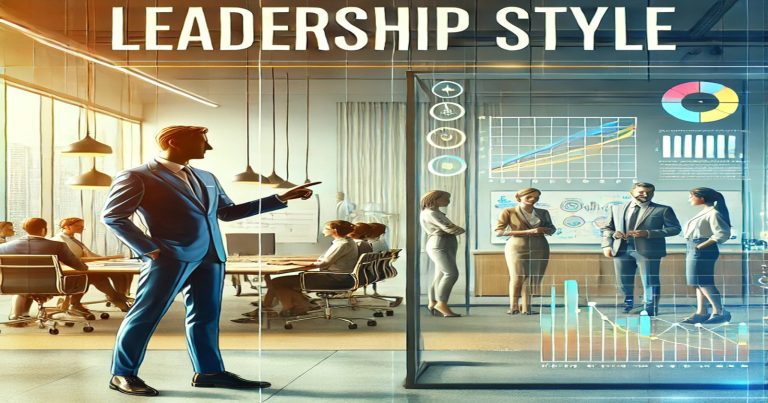Leadership style refers to the specific manner and way a leader leads, motivates, or influences his team to achieve the predetermined goals. Such style defines leaders’ communication means, decision-making methods, as well as styles of relations within their team members. All such aspects impact the morale of the workers, the functioning of the group, and the surroundings of the work itself. Ranging from autocratic to democratic, each has its strengths and weaknesses. Frequently, what dictates the type of leadership will be factors such as the personality of the leader, the dynamics of the team, and organizational objectives. In this article, we discuss the different types of leadership and how to decide which of them might suit your purposes best.
What is Leadership Style?
Leadership style is the process and technique in which a leader leads, inspires, and controls people toward fulfilling set goals. It talks of how leaders intend to communicate to their teams in making decisions for the workplace, hence bringing an appropriate means that may stimulate effective and cohesive working relationships to the organizations involved. Leadership styles determine how organizations will function, shape team dynamics, and even affect the outcome of goals. Whether through controlled structures, collaborative approaches, or granting autonomy, a leader’s style has the most significant effect on performance and morale.
Who is a Leader?
A leader is someone who leads, inspires, and motivates others toward the realization of a common goal or vision. Leadership assumes the responsibility to steer a team, organization, or group in making decisions and providing support in collaboration with them. It helps to motivate and empower others through actions that serve as examples of good character and show traits like integrity, accountability, and resilience. A leader is a person who doesn’t rely on the title to be considered but on his abilities, including gaining people’s trust and confidence in themselves to meet different challenges that bring out the best in his group. This makes them stand as one in whichever business or sector, such as business, sports, and education.
Types of Leadership Style
Leadership styles is the unique ways of leading, influencing, and motivating teams. Each has its strengths and weaknesses and its best-fit scenario. The explanation of these leadership styles will equip the leader to apply the different situations appropriately for managing their team. Let us proceed to a discussion of ten distinct leadership styles with a deeper understanding of how they work and what impact they produce. The types of leadership styles are:-
Autocratic Leadership Style
The autocratic leadership style is also known as authoritarian leadership. This is the centralization of the decision-making authority. The leader makes complete decisions and expects that his team will obey him unconditionally. Under this style of leadership, very few leaders are likely to solicit the opinions of team members to arrive at a solution but instead expect the authority will help them yield results. It proves rather effective when hasty decisions need to be taken or when work requires precision such as during any war operation in an industrial setup as well. However, this is liable to deject the employees too, who prefer to be at the decision-making level. For clear leadership through guidance and structure, such leaders can be seen as useful and at times check innovative thinking, creativity, and work.
Democratic Leadership Style
The democratic leadership style is all about cooperation and involvement. The leaders want participation from the team members and should be involved in decision-making. In this way, the leader values the group’s wisdom, and the decision is made after talking to them. It is a style involving innovation, participation, and reliance on the group. Thus it adapts to any kind of industry that requires innovation. For example, marketing or even the creation of a product might demand such leadership. It makes the decision-making process take longer because deliberations and consultation must be done. It helps create excellent relations within the group, though it demands a leader with the capability of balancing divergent opinions to lead to the whole group coming to agree on a solution.
Laissez-Faire Leadership Style
Laissez-faire is often known as “hands-off” leadership. Here, the leaders avoid influencing the decision-making and even less in directing or controlling how to do jobs within the group. Leaders under laissez-faire leadership trust and do very little guidance or supervision to a large extent in performing their assigned jobs. This is suitable for very competent and motivated employees who are highly self-managing, like in research and development teams or creative industries. It encourages innovation and responsibility from the employees and gives them autonomy to take care of their work. However, it can lead to low productivity or failure to meet deadlines if the team members are not disciplined enough or need more structure.
Bureaucratic Leadership Style
The bureaucratic leadership style relies on existing rules, policies, and procedures. The managers are very rigid regarding all the systems that are being followed in the letter. The bureaucratic leadership style is very prevalent where there is stiff regulation, which may involve government organizations, healthcare, and finance. Bureaucratic leaders prefer structure, consistency, and accountability. Observing the rules keeps things from being messed up. However, in this style of leadership, individuals can be rather inflexible or even stifling to creativity and innovation. Individuals become constrained or even stifled in a system that demands flexibility.
Transformational Leadership Style
Transformational leadership is a style that inspires and motivates employees to work beyond their limits and to realize their maximum potential. Role modeling is an essential characteristic of such leaders; they inspire people toward a meaningful cause and make them grow personally. This is one form of leadership suited to organizations that experience enormous change or are looking to reach some ambitious targets. Transformational leaders create an immense bond with employees and relate the vision of such leaders to an organization’s mission. Thus, motivating employees to give their best performances, the style of such leadership requires immense energy, emotional quotients, and commitment from such leaders.
Transactional Leadership Style
The reward and punishment system is the core of transactional leadership. First, the leaders establish targets and expectations with the team, then track performance. In return for achievement, rewards are administered, but if they are not achieved, then consequences follow. It easily accomplishes short-term goals and keeps the organizational structure. It works best under circumstances where tasks are a cycle, such as in a sales force or manufacturing lines. Transactional leadership may not encourage innovation and staff morale for a long time because it mainly focuses on the outcome rather than on personal development or innovation.
Servant Leadership Style
Servant leadership is characterized by focusing the attention of the leader on a need rather than satisfying their egos or self-interests. It focuses well-being and development of team members in a supportive and sympathetic environment. This approach can create trust, loyalty, and cooperation, which makes it work best in an organization to generate a positive organizational culture. Servant leaders inspire based on humility and selflessness. This style is not suitable when the situation demands quick decision-making or an aggressive commanding voice because of the servant aspect of the leader, which slows down the operation.
Charismatic Leadership Style
Charismatic leadership involves the inspirational and energizing role of a leader through his personality, vision, and communication skills. A charismatic leader has high emotional intelligence and can relate to people at a personal level. This style encourages teams to set challenging goals and face challenges boldly. Charismatic leaders tend to gain loyalty and enthusiasm from employees. However, this style becomes dangerous if the leader depends on charisma and does not create sustainable systems or processes within the organization.
Task-Oriented Leadership Style
Task-oriented leadership focuses on achieving specific goals and efficiently accomplishing tasks. Thus, task-oriented leaders will plan, organize, and monitor tasks to reach deadlines and attain objectives. This type of leadership style may be fine when it comes to scenarios that ask for results in productivity and performance outcomes for instance, even in project management and event planning. However, with a task-oriented approach to managing, the emotions of the employees are neglected just like social needs, and their dissatisfaction and being burnt out due to this call for moderation toward the proper balance of an employee’s morale concerning the outcomes of results that have to come about.
People-Centered or Employee Oriented Leadership Style
People-oriented leaders are concerned with interpersonal relations, teamwork, and helping the members. They would look into workers’ welfare and happiness to ensure that happiness would be followed by the productivity of happy employees. A very people-oriented approach to leadership works well in setting up a very positive culture of work and can promote teamwork. They are very potent organizations that are about employee engagement and retention. Too much on the people side versus the task often shows inadequate productivity, especially if goals and deadlines have not been integrated.
Why Do Leadership Styles Matter?
Organizations overall culture, productivity, and morale are critical and are often defined by a leadership style. The behavior of a leader determines how his or her workers will relate, solve problems, and be successful. If a leader asks, what is your leadership style, that would help a leader align action with organizational objectives and the team’s needs?
The leadership styles will determine the feelings of the employees toward their work. A good leadership style will improve morale, establish trust, and involve the employees. The performance of the employees will be enhanced if they feel valued and supported. For instance, a democratic leadership style that allows participation may lead to increased employee satisfaction.
Influence on Decision-Making
Leadership style determines the mode of decision-making. An autocratic leadership style will allow quick decisions without having to consult with the team, which is very efficient in times of crisis. In contrast, a democratic leadership style calls for the involvement of the team, which enhances teamwork but prolongs the time taken to decide.
Promoting Employee Development
Leadership styles can inspire employees to professionally develop. For example, a laissez-faire leadership style will encourage a sense of responsibility in employees toward their tasks and therefore enhance creativity and decision-making capabilities.
Conflict Resolution
Leaders resolve conflicts based on their styles. Democratic leaders might encourage open discussions, while autocratic leaders may enforce decisions right away to solve problems.
Leadership Style FAQs
1. What is leadership style?
Leadership style is the way a leader approaches and strategizes on how to guide and influence their team. This includes how they communicate, make decisions, and handle challenges.
2 . What is an autocratic leadership style?
The autocratic leadership style is centralized in that the leader holds all the authority and expects strict adherence to their instructions.
3. What are the types of leadership styles?
Examples include autocratic, democratic, bureaucratic, and laissez-faire. All have their traits and are suitable for certain situations.
4. What is bureaucratic leadership?
The bureaucratic leadership follows the rule-book and process which is very systematic and ensures regulatory compliance and follow-through. The ideal application scenario is for industries that rely heavily on compliance.
5. What is your leadership style?
Your style of leadership has to do with how you decide, the way you interact with your teams, and the way you communicate. Self-analysis and feedback will help indicate which one you would have.


